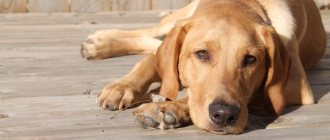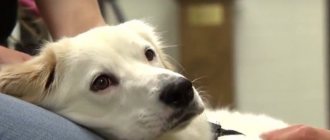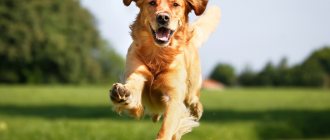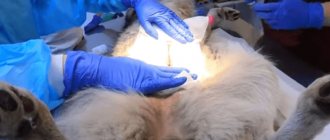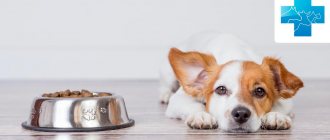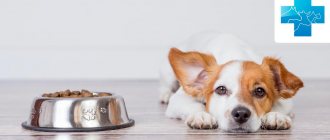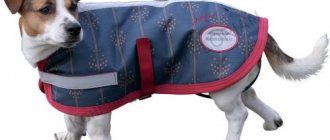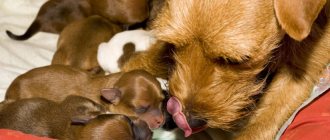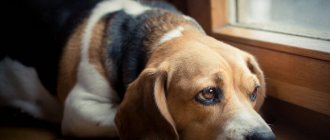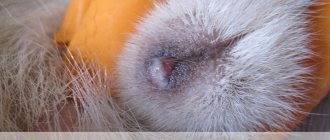Even with a successful operation, caring for the dog after sterilization is extremely necessary. If the animal is treated incorrectly during the period of its rehabilitation, all the efforts of the surgeon will be nullified and the dog will definitely need the help of a veterinarian. The pet owner should keep in mind those symptoms that require contacting a specialist. It is important to know how to speed up the animal’s recovery process and what dog behavior can be considered normal.
Transporting a dog after sterilization
Caring for your dog begins after leaving the veterinary clinic. Serious anesthesia and abdominal surgery are real stress for the animal. To keep your pet’s health safe, write down all the recommendations at the doctor’s appointment and follow them strictly as written; do not trust the advice of friends who do not have a medical education. The veterinarian prescribes a course to restore the animal, according to its specific case and on an individual basis.
A dog is released after sterilization only when it is able to stand on all four legs and walk. However, this does not mean that you can walk home. If the dog is small, you can carry it home in your arms, but for large dogs, you need to organize transportation by car. The doctor may leave your pet overnight at the clinic if she is unable to move on her own or appears unresponsive after being given painkillers.
It is better to ask one of your friends or relatives to go get the dog with you. Often, owners, due to their excitement, forget everything the doctor tells them. A friend in this matter will become your spare ears, who will listen carefully, and most importantly, remember everything the veterinarian says.
A partner will easily hold the door for you to leave the clinic, open the car and help load the dog. During anesthesia, all the animal's organs begin to work much more slowly, and it can freeze, even in the summer. Therefore, it is better to transport the animal in a box or cover it by placing it on the car seat.
When you arrive home, write down any questions you may have so you don’t forget to ask your doctor at your next appointment. Most clinics provide not only verbal recommendations, but also write everything down on paper so that you can clearly follow the instructions. After asking questions and receiving answers to them, you will become as prepared as possible and will know how to care for your dog after sterilization.
At what age is surgery performed?
There is a misconception that male dogs are castrated and females are spayed. In fact, both types of surgery are available for dogs of both sexes. The first type involves removing the testes or uterus and ovaries, the second involves ligating the fallopian tubes or spermatic cords.
A huge disadvantage of sterilization is that the dog’s desire does not disappear and all manifestations of sexual behavior are preserved. Castration brings peace not only to the owner, but also to the animal itself.
Expert opinion
Anna Abramenko
An avid dog lover. Experience in veterinary medicine since 2009.
Ask a Question
Castration or sterilization too early can lead to unpredictable consequences, including problems with the genitourinary system
The right time for the operation is the first thing that owners think about. The best moment is considered to be the beginning of puberty. The dog’s sexual instinct has not yet fully formed; it does not mark its territory. At the same time, the development of the body is coming to an end, the operation will not harm it.
It is better to castrate males at 7-8 months. This applies to small dogs. For large breeds, a period of 1-1.5 years is optimal. It is customary to operate on female dogs before their first heat, at the age of 6-9 months.
Castration and sterilization are also acceptable for adults. But you need to take into account that their health is no longer as strong as that of puppies, so the risk of complications increases, the stitches take a long time to heal, and the dog’s rehabilitation process is delayed.
This is interesting: What is the difference between castration and sterilization
In older, uncastrated animals, the risk of cancer increases. If the dog is not operated on in time, it is worth doing it before aging begins. When a bitch is used for breeding, her last birth should not be later than 6 years. Afterwards, the pet can be neutered.
First day
When you arrive home, give your dog as much attention as possible. To prevent your pet from suffering from muscle pain and general weakness beyond what he already experiences, place him on a flat surface or mattress and cover him with a blanket. The dog's bed should not be located in a draft, but it would also be unwise to place it near the radiator. Under no circumstances should you warm your dog or use a heating pad; this method can cause internal bleeding. In a dream, a dog can urinate, so it is better to put a diaper under it, and do not forget to change it on time so that the animal does not freeze.
Once every half hour, the dog should change its position, shift it from one side to the other. This way you will eliminate the possibility of numbness in the limbs and pulmonary edema. When the dog sleeps after anesthesia, all care consists only of your observation of it.
Smooth breathing and heart rate will be important indicators of normal condition. A good sign is a reaction to any irritants. For example, if you tickle its paw, the animal will pull it back. If such a reaction is absent, this means that the level of the drug for inducing anesthesia is still quite high and the animal will not wake up soon.
Restoring a dog after sterilization is a rather difficult process. To prevent pain in the animal’s throat and pain in the eyes during this period, you need to moisturize the mucous membranes once every half hour using “artificial tears” drops. If the animal is already reacting to stimuli, moving and shifting from side to side, and the surgeon has treated its eyelids with a special gel, then such measures will not be necessary.
Actions to take if your dog's condition worsens
Most pet dog owners do not know what to do if their pet's condition begins to deteriorate after surgery. If you notice signs of illness, contact your doctor immediately and do not try to help the animal yourself. In rare cases, complications after castration of a male dog of a general nature are noted in the form of pulmonary edema and disorders of the cardiovascular system. This situation is accompanied by the following symptoms:
- the dog breathes with an open mouth, its breathing becomes intermittent, heavy and uneven. You can hear squelching and wheezing in the chest;
- the temperature may rise or fall below normal by 1 degree. A slight increase or decrease in temperature by half a degree during anesthesia or in the first few days after surgery is considered normal;
- the heart rhythm becomes confused, the heart either freezes or begins to beat too quickly. The mucous membranes become pale or acquire a bluish tint. Minor trembling may occur, but if it does not go away within an hour or turns into seizures, go to the doctor immediately.
The dog’s recovery after surgery and recovery from the state of anesthesia often exhausts the owner himself. From the outside, the behavior of a dog after recovering from anesthesia looks very strange and frightening. She bumps into corners when walking, can freeze in one position, staggers, and reacts poorly to her owner’s voice. You should not be afraid of such behavior, because it is considered the norm.
The pet's behavior can change radically: it becomes aggressive, panic is possible, the animal can hide under the bed and not allow family members near it. When motor functions are restored, try to calm the dog down, sit next to it, let it sleep or just lie down in a state of rest. If your pet doesn’t allow anyone close to him, don’t insist, close all dangerous places where he can get in and just watch the situation from the outside.
Any change in the dog's behavior or condition should be noted by you. If necessary, call your doctor and clarify your concerns. Don’t be shy about distracting the doctor from work with your calls, because such consultations in the postoperative period are included in the cost of treatment.
Features of skin and coat care
After surgery, you need to regularly examine your pet's fur and skin. Particular attention is paid to the seam area. It should always be clean to avoid infection of the wound.
You can apply a sterile bandage to it.
The coat of most breeds does not change its structure or condition after castration, so it does not require special care. It is not recommended to use any products until the seam has completely healed. You should also not wash your pet until rehabilitation is complete.
Seam processing
The discomfort of sutures after surgery varies between males and females. Caring for a male dog after castration does not require as much effort as the rehabilitation of a female dog. Some surgeons prescribe pain medications right away, others only as needed.
The acceptance of such funds is due to the following:
- the owner knows that his dog cannot tolerate pain, the specialist should be notified about this immediately;
- The dog owner sees that the rehabilitation period is complicated by severe pain. For example, during defecation, the dog whines, moves with extreme caution and cannot make sudden movements.
The use of painkillers can greatly speed up the recovery process, then the dog will not damage the suture with its teeth, and will also move normally without resting. Many specialists immediately prescribe a course of antibiotics to prevent the occurrence of an inflammatory process.
Whether the seam needs to be treated after it has been applied depends on:
- the material of the seams themselves;
- method of its application;
- method of treatment after surgery.
In each case, the drugs will be prescribed or not prescribed by the doctor. If the doctor says that there is no need to treat the suture, and you notice inflammation, swelling or redness in this area, make an appointment with a veterinarian.
After sterilization, the seam should be dry, without redness, crusts or other growths. With normal healing, the appearance of the seam will become better and better every day.
The need for blankets
To protect the seam from bacteria and mechanical damage, the dog will need a blanket. In modern clinics, a blanket is put on the dog immediately after surgery. One copy will not be enough, because the thin material quickly gets wet and dirty. The bandage should be changed once a day and be sure to pet it before putting it on your dog. When processing seams, you should not remove the blanket; you can only untie a couple of ribbons and move the material to the side.
If the dog constantly strives to take off the blanket, put an Elizabethan collar on it or constantly monitor it so that it still does not manage to touch it. To prevent the seam from unraveling, make sure that the dog does not play outdoor games or jump; it is better to give preference to light and quiet walks. If it is difficult for your dog to climb stairs, then it is better to set up a toilet at home for the first few days.
Whether suture removal is necessary will depend on the suture material and how it was placed. In some cases, removal of sutures is not required, because the threads will dissolve and dry out on their own. The veterinarian will tell you whether the suture needs to be removed and when it needs to be done. On average, sutures are removed 2 weeks after the operation.
The need for blankets
Cat after sterilization: care at home
After the sterilization operation and treatment of the sutures, in order to prevent infection from entering the wound, the dog is put on a special blanket, and, if necessary, a collar. A postoperative blanket is also necessary to prevent the dog from licking the seam. It also supports the abdominal cavity, preventing the formation of hernias and suture divergence.
The blanket should always be clean. When going outside with your pet, it should be protected with a jumpsuit, and if it gets dirty, change it for a clean one. During a winter walk, the blanket is insulated on top to prevent the seams from getting cold. This accessory is worn, if there are no complications, for 2-3 weeks. During this time, the pet should not be subjected to physical stress.
Postoperative blanket
The dog may not like wearing foreign things; it will try to take it off, refuse to eat, and in every possible way show inconvenience in movement. You should not follow the dog’s lead, as this is fraught with bad consequences. While your pet is recovering, wearing a blanket is essential.
Nutrition
Compliance with diet during the rehabilitation period is an extremely important aspect on the path to the full recovery of the four-legged animal. After recovery from anesthesia, the cardiovascular and respiratory systems are the first to return to normal function; the digestive system joins a little later.
A dog is quite capable of starving for 3 days without harm to its body. If you rush and feed your dog ahead of schedule, there is a chance of causing vomiting or, even worse, causing the development of pneumonia due to food particles getting into the lungs, and this is extremely life-threatening.
You can give your dog water when it can stand on its feet normally and can walk. If the dog has not yet recovered from anesthesia, then water is poured into the cheek in small portions. The animal should be fed correctly so that the seam does not come apart during defecation, which can cause constipation. To avoid such unpleasant situations, you should start feeding the dog only when the signs of anesthesia completely disappear.
In the first week, give preference to canned food, mousses, and dry food, which is pre-soaked in water. After a week, you can return to your daily diet, but make the portion 20% less than usual. Dry food is available for sterilized dogs, which should be used to fatten the pet after its recovery. This will help avoid excess weight gain, which often accompanies spayed bitches.
Complications
Despite the fact that castration is not considered one of the most difficult operations, a number of complications can still arise after it. To minimize this risk, you must take into account the recommendations and advice of your veterinarian.
The following problems often arise:
- Sometimes in the first days the pet becomes constipated. In this case, you need to reconsider his diet. It should only contain liquid food.
- Lack or decreased appetite. For the first 2-3 days this is normal, but then it requires the help of a veterinarian.
- Drowsiness and weakness.
- Poor orientation on the ground, especially on the first day.
These symptoms usually go away on their own. But there are signs that indicate the presence of serious problems and require contacting a clinic:
- suppuration, suture rupture;
- elevated temperature;
- pain when walking;
- urinary incontinence;
- hernia;
- tumor in the operated area;
- cyanosis of tissues (a sign of dangerous intra-abdominal bleeding).
Expert opinion
Anna Abramenko
An avid dog lover. Experience in veterinary medicine since 2009.
Ask a Question
In order not to further disturb the dog or aggravate its situation, a specialist can be called to your home.
Consequences of spaying and neutering a dog
Like any other surgery, sterilization has a number of complications that can arise. Typically, such complications accompany bitches who have reached the age of 7 years.
The dog may begin to gain excess weight due to changes in metabolism. To avoid this problem, you should reduce each serving of food and review your diet. Neutered dogs often suffer from urinary incontinence. In this case, it is important to find the true reason.
It is likely that the dog had urinary tract problems before surgery. Hormonal levels change, which leads to a weakening of the bladder. Lack of estrogen can also cause incontinence. Lack of estrogen often leads to baldness in female dogs. There is no prevention for this problem. Treatment is taking female hormones.
Knowing everything about complications in the postoperative period, you will eliminate the likelihood of developing a serious condition that could threaten the animal’s life. To summarize, we note the most common complications that should not be left without your attention:
- urinary incontinence;
- inflammation of sutures;
- seam rupture;
- addition of infection;
- internal bleeding;
- the appearance of a postoperative hernia.
How does a dog behave after castration and is it necessary? The animal may be lethargic, she will have no appetite, and there is a risk of chills, but not for long. At first after anesthesia, the dog will not be able to walk, roll over, or drink. This may scare you, but it’s completely in vain, this condition is considered the norm. You will have to help her with this in order to prevent the development of complications, and simply speed up the recovery process of your pet.
When is a veterinarian needed?
It is important to call your veterinarian promptly if the following situations occur:
- 2 days after the operation the dog refuses to eat and drink. Usually by this time the animal should be eating and drinking normally, and if this does not happen, it means that he is worried about painful sensations, do not hesitate and urgently call the doctor;
- discharge began from the wound. When the wound heals, it is dry. If you see pus or blood coming out, contact your doctor immediately;
- nausea and diarrhea. Often, anesthetics can cause nausea or diarrhea, which occurs as a result of stomach irritation. However, if your dog is vomiting after surgery, you should consult a doctor;
- swollen abdomen, lethargy and weakness. If your dog's shape changes, weakness increases without regaining energy, and the stomach becomes swollen, do not hesitate to call your doctor and make an appointment.
If you notice one of the symptoms that indicates that the dog is not going well through the rehabilitation period and is not recovering, call your veterinarian and tell him about it. Surround your pet with maximum care, monitor its condition and prevent its health from deteriorating. A dog, just like a person, experiences a difficult postoperative period, so do not skimp on attention and resources, follow all the doctor’s recommendations. After recovery, the dog will definitely thank you for your efforts and care with its affection and friendliness.
Currently reading:
- How difficult it is for dogs to endure and recover from anesthesia
- Games to choose for training a dog
- Everything about the Malinois dog breed, originally from Belgium
- Recommendations for obedience of a dog if it growls
Possible complications during anesthesia
Many operations on dogs use anesthesia. It is necessary for pain relief and immobilization of the animal. During its action, a number of complications may arise. This is due to the effect of anesthesia on the centers of the brain.
The most common are:
- breathing problems: slowing, obstruction, hypoxia, bronchiole spasm, pulmonary edema;
- cardiac disorders: bradycardia, tachycardia, arrhythmia, ventricular fibrillation, cardiac arrest;
- decrease in body temperature;
- allergic reactions;
- vomiting, regurgitation (reversal) of stomach contents;
- delayed awakening.
Complications most often occur for several reasons:
- insufficient preoperative examination;
- incorrect choice of method or drug for anesthesia;
- drug intolerance;
- errors in calculating the administered anesthesia.
Expert opinion
Anna Abramenko
An avid dog lover. Experience in veterinary medicine since 2009.
Ask a Question
To avoid dangerous situations, the owner must carefully select a clinic and specialist.
Fortunately, in pets without chronic pathologies, surgery usually proceeds without complications. Castration lasts 10-15 minutes for males and 30-60 for females. The awakening time takes from 2-3 hours to a day (by this time the dog finally comes to his senses).
How long a pet recovers from anesthesia depends on the type and method of administration of anesthesia, as well as on the individual characteristics of each animal.
